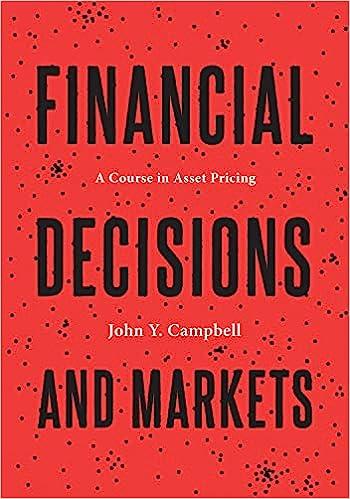Consider a simplified model of mortgage choice with three dates, 0,1 , and 2. At date 0
Question:
Consider a simplified model of mortgage choice with three dates, 0,1 , and 2. At date 0 , a household buys a house of value \(M\) and finances it with a mortgage of equal value (so the loan-to-value ratio is \(100 \%\) ). At date 1, the household pays interest on the mortgage. At date 2, the household sells the house and repays the mortgage with interest. The household also receives a fixed income \(Y\) and chooses nonhousing consumption \(C\) at each date.
Mortgage contracts are specified in nominal terms, so the debt \(M\) is nominal. The house, however, is a real asset whose nominal value grows with inflation. The riskfree real interest rate is constant at \(r\), but inflation can take one of two values, low or high, and uncertainty about inflation is resolved between dates 0 and 1 . Thus, gross inflation between date 0 and date 1 is either \(\left(1+\pi_{L}ight)\) or \(\left(1+\pi_{H}ight)\), and cumulative gross inflation between dates 0 and 2 is either \(\left(1+\pi_{L}ight)^{2}\) or \(\left(1+\pi_{H}ight)^{2}\). This structure captures the historical tendency for inflation movements to be highly persistent.
The household can choose between two standard mortgage contracts. An adjustablerate mortgage (ARM) requires nominal payments of \(R_{A H} M\) at date 1 and \(\left(1+R_{A H}ight) M\)
at date 2 if inflation is high, and \(R_{A L} M\) at date 1 and \(\left(1+R_{A L}ight) M\) at date 2 if inflation is low. A fixed-rate mortgage (FRM) requires a nominal payment of \(R_{F} M\) at date 1 , and a nominal payment of \(\left(1+R_{F}ight) M\) at date 2 . The fixed mortgage rate \(R_{F}\) is set at date 0 , before inflation is observed. \({ }^{17}\)
For simplicity we assume that there is no possibility of default and that lenders are risk-neutral so interest rates on both types of mortgages are set to equate the expected present value of real payments with the mortgage principal \(M\).
(a) ARM properties.
(i) Solve for the interest rates \(R_{A H}\) and \(R_{A L}\).
(ii) Write an expression for the required real payment on an ARM in period 1 as a function of \(M, r\), and \(\pi_{i}\). Show that this payment is increasing in the inflation rate \(\pi_{i}\).
(iii) Write an expression for the required real payment on an ARM in period 2 as a function of \(M, r\), and \(\pi_{i}\). Show that this payment is decreasing in the inflation rate.
(iv) Show that the sum of these payments, discounted at the real interest rate \(r\), does not depend on the inflation rate and always equals \(M\).
(b) FRM properties.
(i) Taking as given the FRM rate \(R_{F}\), write an expression for the required real payment on an FRM in period 1 as a function of \(M, \pi_{i}\), and \(R_{F}\). Show that this payment is decreasing in the inflation rate \(\pi_{i}\).
(ii) Write an expression for the required real payment on an FRM in period 2 as a function of \(M, \pi_{i}\), and \(R_{F}\). Show that this payment is also decreasing in the inflation rate and therefore that the sum of all payments, discounted at the real interest rate \(r\), is decreasing in the inflation rate.
(c) Mortgage choice by unconstrained households. Use your results from parts
(a) and
(b) to show that risk-averse households that are freely able to borrow and lend between periods 1 and 2 will always prefer ARMs unless the FRM rate is lower than the rate that equates the expected present value of mortgage payments across ARMs and FRMs. Explain the intuition for this result.
(d) Mortgage choice by constrained households. Now consider a risk-averse household that is borrowing-constrained in periods 1 and 2. In each of these periods, the household's consumption equals income less required mortgage payments.
(i) Write expressions for consumption in periods 1 and 2 if the household has an ARM, and if the household has an FRM.
(ii) Use a Taylor approximation around the average inflation rate to show that for small inflation volatility \(\sigma_{\pi}\), the standard deviation of consumption in period 1 is, \(M \sigma_{\pi} /(1+\pi)^{2}\) for a household with an ARM, and only \(R_{F}\) times as large for a household with an FRM. Explain the intuition for this result.
(iii) Repeat this calculation for the standard deviation of consumption in period 2. Which type of mortgage implies greater consumption volatility in period 2? Explain.
(iv) Using the above results, explain why a risk-averse borrowing-constrained household might prefer an FRM to an ARM.
(e) Refinanceable FRMs. FRMs in the US are refinanceable. We now consider the implications of allowing a household with an FRM in this model to repay the mortgage at nominal face value in period 1 and take out an ARM between periods 1 and 2.
(i) Taking the refinanceable FRM rate \(R_{R F}\) as given, what are the required payments in periods 1 and 2 for a household with a refinanceable FRM, if inflation is low and if inflation is high?
(ii) Show that if lenders are risk-neutral and equate the expected present value of all payments across mortgage types, then the refinanceable FRM has higher expected payments in period 1 than an ARM, and lower expected payments in period 2.
(iii) Use the above results to argue that a risk-neutral household that is borrowingconstrained in period 1 will prefer an ARM, but a sufficiently risk-averse borrowing-constrained household will prefer an FRM.
(f) Alternative mortgages. Discuss alternative forms of mortgage contracts that would be preferable for risk-averse borrowers than either standard ARMs or FRMs.
Step by Step Answer:

Financial Decisions And Markets A Course In Asset Pricing
ISBN: 9780691160801
1st Edition
Authors: John Y. Campbell





